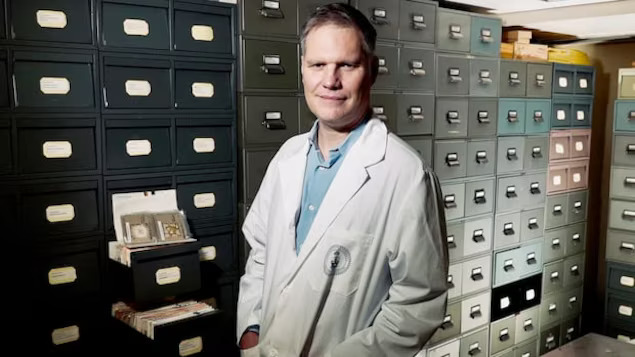Canada News
Canada set to lose irreplaceable ’treasure trove’ of fungi
By Emily Chung, CBC News, RCI

A University of Toronto collection of living fungi, long used in the development of life-saving medical breakthroughs, like penicillin, could close over a lack of funding. Scientists across Canada are concerned its loss could complicate the development of new drugs. Photo: CBC News
15,000 live strains used to research emerging diseases, biodiversity
Canadians could soon lose access to a unique public collection of fungi that scientists say is crucial for important research, such as developing new drugs to treat antibiotic-resistant pathogens and treatments for fungal diseases emerging in a warmer climate.
The public biobank at the UAMH Centre for Global Microfungal Biodiversity at the University of Toronto is a treasure trove
of 12,000 strains of fungi collected since 1933, said James Scott, a professor at U of T’s Dalla Lana School of Public Health and director of the centre.
We are really the only one of those in Canada for fungi,
he said, adding that it’s used by Canadian researchers from industry, public health labs and colleges and universities.
It’s also billed as the largest collection of disease-causing fungi in the Western hemisphere, providing a precious opportunity for scientists in Canada to research those diseases and their treatments.
But it has run out of funding.
Unless a government or other funder steps up, the collection will likely be sent overseas. When that happens, accessing them will cost a lot more and require lots of paperwork, Scott predicts.
In some cases, it may not be possible,
he said, especially with some disease-causing fungi or specimens originating from certain countries.
Last week, Scott wrote a letter to Ontario Minister of Economic Development Vic Fedeli describing the dire situation
facing the centre, noting that Ontario Premier Doug Ford recently announced a $143-million investment in a life sciences strategy for Ontario.
Securing the future of this biorepository, which is already recognized as a world-leading reference library of living microfungi, would be an easy win for Premier Ford’s life sciences initiative,
Scott wrote.
As of Wednesday, he hadn’t heard back yet.
Thousands of unique finds
The collection contains thousands of strains of fungi from more than 3,200 species — including some that have likely never been described by science — gathered over nearly a century. They’re in little vials, freeze-dried or stored in tanks of nitrogen vapour or under water or mineral oil, waiting to be revived as needed.
About two-thirds of the strains in the Canadian fungal library are unique to this collection and found in no other fungal repository in the world, Scott said.
Half the specimens are from Canada, and they represent ecosystems ranging from Pelee Island to the High Arctic.
Mary Berbee, a professor emeritus at the University of British Columbia who uses the collection, noted that unlike most plants and animals, fungi live their whole lives hidden,
such as underground or in another organism.
They emerge (as mushrooms or mold, for example) only when doing something important, such as causing disease or reproducing.
But if you miss that opportunity, you may never have it again,
Berbee said. You may have great difficulty finding the same organism.
Her own research is on mycorrhizal fungi, which are associated with the roots of plants and have a mutually beneficial relationship exchanging nutrients with those plants. She deposits new specimens she finds in the fungal repository so others can study them, including new species.
I suspect there are many more fungi, new to science, that are in that collection that will be discovered,
she said.
Biggest collection of disease-causing fungi
The collection also contains more fungi that cause diseases in humans and animals than any other in the Western hemisphere, Scott said.
We have a full representation of all of the most serious fungal pathogens of humans and animals that are known,
he said, adding that it’s also the largest collection of fungal pathogens affecting reptiles, sea corals and bats, whose populations are currently being decimated by a fungal disease called white-nose syndrome.
Berbee noted that climate change means many fungal diseases are creeping north, such as deadly Valley Fever, which has been most common in California and Arizona, but has started popping up as far north as Oregon and Washington state.
WATCH | A deadly fungus is creeping toward Canada because of climate change:
A deadly fungus is creeping toward Canada because of climate change
A deadly fungus —known for causing a potentially fatal disease called Valley Fever — lurks in the soil of the southwestern U.S. It’s not in Canada yet, but thanks to climate change, it’s moving north.
Scott said it’s not just human diseases on the move.
We absolutely are seeing climate change-driven increases in certain diseases that stand to wipe out populations of certain animals,
he said. And, you know, many of those diseases are fungal diseases. They’re probably the most important emerging diseases.
A source of potential cures?
Scott said often the key to figuring out what treatment works is to grow the disease-causing strain and try to understand how it lives and works. If you don’t have the thing, you can’t do that.
He said the biobank is where researchers would go to get the right strain.
Berbee said that wouldn’t be easy for Canadian researchers if the collection were to move overseas. Because they can cause disease, she said, there are strict controls on the movement of cultures.
It could take months to get the permits.
Scott said in some cases, it might not be possible at all — as has been the case for strains of other kinds of pathogens, such as anthrax, that Canadian researchers needed from the U.S.
Ayush Kumar is a microbiology professor at the University of Manitoba who uses the fungal collection in his search for new drugs to treat disease.
He said antibiotic resistance is a growing problem. His lab has been screening some of the fungi in the biobank to see if they produce antibiotics.
Fungi have been probably the most important source of antibiotics,
he said, including the first: penicillin.
Kumar has promising preliminary data about one fungus that may work against Acetinobacter baumanii bacteria that are resistant to almost every class of antibiotic currently in use.
He worries the fungi may be hard to access if they move to Europe or Asia, due to safety regulations.
It would be a great loss,
he said.
Potential futures for the biobank
Scott already saved the collection once. It was originally housed at the University of Alberta — UAMH stands for University of Alberta Microfungus Collection and Herbarium — and maintained with a federal grant from the National Sciences and Engineering Research Council.
But the funding program ended in 2012 under prime minister Stephen Harper, who cut many scientific research and monitoring programs and facilities during his tenure (new window).
Scott said he was approached by the collection’s curator, who said it was destined for the trash if he didn’t take it.
You can’t replace that if it goes into the dumpster,
he said. He took the collection to the University of Toronto with him, hopeful that he could find another funding source.
Since then, he said, multiple grant applications have been rejected. He even created a board game called Mycology to try and raise money for the biobank.
User fees have covered about a fifth of the $130,000 a year required to operate the biobank. Scott has donated $100,000 a year from his private company to make up the difference, but said that’s no longer feasible.
If he doesn’t find a solution in the next year, he said the collection will likely be absorbed into a repository in the Netherlands that is one of the largest in the world (new window) or the State Key Laboratory in Beijing, China.
We’ve reached a point now where it just doesn’t look possible to maintain this biobank resource in Canada,
Scott said.
This article is republished from RCI.





















